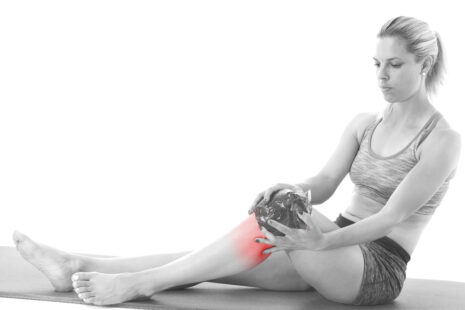Pain from a torn meniscus can manifest in different areas of the knee, depending on the location and severity of the tear. The meniscus is a C-shaped cartilage structure that serves as a cushion and stabilizer within the knee joint. When the meniscus is torn, it can cause pain and other symptoms that may vary depending on the specific characteristics of the injury.
Here are some common locations where knee pain may occur with a torn meniscus…
- Medial Joint Line – The medial meniscus is located on the inner aspect of the knee joint. Pain along the medial (inner) joint line of the knee is a common symptom of a medial meniscus tear. Individuals with a medial meniscus tear may experience pain or tenderness along the inner edge of the knee joint, particularly when pressing on the area or with certain movements.
- Lateral Joint Line – The lateral meniscus is situated on the outer aspect of the knee joint. Pain along the lateral (outer) joint line of the knee can occur with a tear of the lateral meniscus. Similar to a medial meniscus tear, individuals with a lateral meniscus tear may experience pain or tenderness along the outer edge of the knee joint.
- Deep Knee Pain – Some individuals with a torn meniscus may experience deep, aching pain within the knee joint, rather than localized pain along the joint line. The pain may be aggravated by weight-bearing activities, twisting motions, or movements that compress the knee joint.
- Locking or Catching Sensation – In addition to pain, a torn meniscus may cause mechanical symptoms such as locking or catching sensations in the knee joint. This occurs when a fragment of the torn meniscus becomes caught between the joint surfaces, causing the knee to momentarily “lock” or “catch” during movement.
- Swelling – Swelling (effusion) within the knee joint is a common symptom of a torn meniscus. The knee may appear swollen or feel full or tight due to the accumulation of fluid within the joint space. Swelling may exacerbate pain and restrict knee movement.
- Limited Range of Motion – A torn meniscus can lead to stiffness and limited range of motion in the knee joint, particularly with movements that involve bending or straightening the knee. Individuals may experience difficulty fully extending or flexing the knee due to pain and mechanical restrictions.
It’s important to note that the symptoms of a torn meniscus can vary depending on factors such as the size, location, and severity of the tear, as well as individual factors such as age, activity level, and presence of other knee injuries or conditions. If you suspect you may have a torn meniscus or are experiencing persistent knee pain or symptoms, it’s advisable to consult with a healthcare professional for evaluation, diagnosis, and appropriate management.




